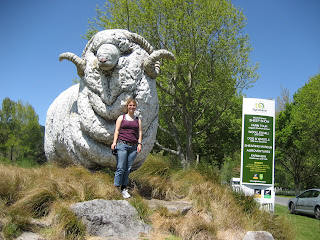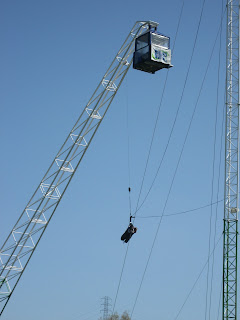It was Labor Day weekend last week in New Zealand, and like in America, we had a three-day weekend from Saturday to Monday. To Celebrate, I traveled once again with my Cousin David and his wife Sue to Rotorua. This time we hooked up with David’s and Sue’s daughter Sarah and her family, James her husband, and Hamish and Penny her children.
On Saturday, we all traveled to the Agrodome to see a sheep shearing and herding demonstration, and a tour of the Agrodome farm.
The sheep shearing demonstration was part of a show inside the Agrodome’s main building. The show consisted of a brief description of each type of sheep they had on the premises with live models. They had trained the sheep to run up to their specific spot on the podium for a food reward. They started with one of the most famous breed of sheep the Merino and went down the line covering first the wool breeds and then the multipurpose and finally the meat breeds.
This was followed by a sheep brought on the stage for the sheep sheering demonstration. While this was not mentioned in the show according to Steve Sheep sheering is known as shagging in New Zealand. Apparently he was joking and I believed him. Grrrrr
To my surprise, a lactating Friesian cow was brought on stage next for a milking demonstration. People drawn from the crowd were given a Certificate of Udderance for successfully getting milk into a bucket.
A milk-drinking contest then ensued between five lambs being fed by audience members.
New Zealand herding dogs were introduced next. One herded three Pekin ducks around the stage. The others demonstrated their jumping, parking and standing on sheep’s backs prowess.
The Show ended with a real sheep herding demonstration outside followed by a carding machine demonstration.
Our second adventure involved boarding a luxury hay wagon, a tram pulled by a tractor, for a tour of the “working farm”. I say “working farm” because supposedly, they do raise and sell animals at this farm, but I would be surprised if the money they raised from the animals could pay for the upkeep.
We stared by going to the emu and ostrich pen. This pen, right next to a giant swing where a family of three were being hoisted up by a cable and dropped right in front of us.
Feeding the emu’s amused me. You held our your flat hand and their beaks down on your hand with the hardest peck.
I held Hamish’s hand out flat so that he could feel how it felt. Considering how hard and fast they move I was amazed how well he responded.
It was then on to the Kiwi fields were we stopped by the education center to look at a fruit press and to try some Kiwi juice, honey and wine, for those over 18. Of all, I thought the honey won overall because, it had a distinctive but pleasant taste. The wine tasted identical to the Sutter Home Moscato and the kiwi juice tasted like generic juice.
Off we went again on the wagon to a field filled with a lama, many alpacas one emu and many sheep. The highpoint of this event is that Penny, got crowded by brown sheep and broke down, declaring that she didn’t like brown sheep because they were overly aggressive.
At the second to last pen we visited, I got to hold a baby lamb in my arms. David held it too.
The last pen held the bovine. We were not allowed out of the wagon, because due to being hand fed the cattle were too tame and rather pushy including the two bulls, one Friesian and a Hereford. One well over 1000 lb. Included with the bulls were a jersey, Frisian, and Angus cows, and a miniature Angus.
With that, the tour ended. After lunch, I took a picture of Penny on top of a statue of a Kiwi. She asked me if I had meet Lighting McQueen. I did not realize until later that she meant the main character from the movie Cars.
Back at the Bach I went kayaking on the lake and lost my watch swimming to shore.





















































